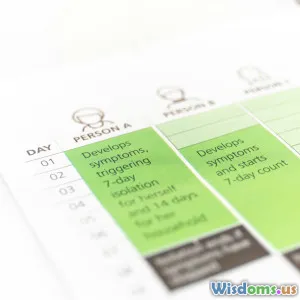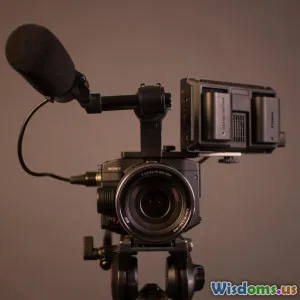
Building a Strong Content Strategy
7 min read Master the art of building a strong content strategy to elevate your brand, engage your audience, and drive measurable success. (0 Reviews)
Building a Strong Content Strategy: The Ultimate Guide
Creating compelling content is no longer just about quality; it's about strategy. A well-crafted content strategy can transform your brand's presence, attract your ideal audience, and convert casual visitors into loyal customers. But what exactly constitutes a strong content strategy? And how do you develop one that stands the test of time?
In this article, we'll dive into the foundations of building an effective content strategy, enriched with real-world examples and actionable insights to equip you with tools that turn ideas into impactful outcomes.
Understanding What a Content Strategy Really Is
Before diving into tactics, it's crucial to understand that content strategy acts as the roadmap for your content creation efforts. It defines who you’re speaking to, what you want to say, how you’ll say it, and the outcomes you’re aiming for.
Ann Handley, a pioneer in digital marketing, emphasizes, “Good content isn’t about good storytelling. It’s about telling a true story well.” This means your content strategy should align with your brand’s authentic voice and business goals.
Key Components Include:
- Audience Insight: Who are your target readers? Understanding demographics, pain points, and preferences is non-negotiable.
- Content Goals: Are you focusing on brand awareness, lead generation, or customer education?
- Content Types & Formats: Blogs, videos, podcasts, infographics, etc.—which mix best fits your audience and goals?
- Publishing Schedule: Regularity matters. Consistency keeps your audience engaged and nurtures SEO.
- Measurement & Adjustments: A feedback loop using analytics guides continual improvement.
Step 1: Conduct Deep Audience Research
An exceptional content strategy starts with knowing your audience intimately. Tools like Google Analytics, Facebook Insights, and customer surveys can provide behavioral data. But don’t stop there—develop buyer personas to humanize your target customers.
Example:
Buffer, a social media management platform, detailed personas that include demographics, job titles, challenges, and content preferences. This helped tailor their content to address specific pain points like "time constraints for social media" and "finding relevant content topics."
Practical Tips:
- Use qualitative interviews to uncover nuanced motivations.
- Analyze competitors’ audience engagement for hints.
- Leverage social listening to monitor conversations relevant to your niche.
Step 2: Define Clear, Measurable Goals
“By failing to prepare, you are preparing to fail.” - Benjamin Franklin’s words remain true when setting content goals.
Are you creating content to increase site traffic by 30% in six months? Or to boost webinar sign-ups? Clarity creates focus.
Use the SMART Framework:
- Specific: Identify what exact outcome is desired.
- Measurable: Attach numeric values (visits, conversions).
- Achievable: Ensure goals are realistic.
- Relevant: Align with broader business objectives.
- Time-bound: Set deadlines.
Content marketers who set goals are 376% more likely to report success according to a 2022 Content Marketing Institute survey.
Step 3: Craft Your Messaging and Content Pillars
Your messaging must echo core brand values while addressing audience desires and objections.
Content Pillars Explained:
These are thematic buckets that your content consistently supports. For example, a fitness brand might focus on:
- Nutrition Education
- Workout Routines
- Mental Health & Wellness
This structure keeps content focused and builds brand authority.
Real-World Insight: HubSpot outlines content pillars as one reason they grew from a 0-traffic blog to over 3 million monthly visitors. Consistency in topic clusters boosted their SEO and audience trust.
Step 4: Decide on Content Types and Channels
Matching content formats to audience preferences optimizes engagement.
- Blogs for SEO and education
- Videos for tutorials and storytelling
- Podcasts for on-the-go learning
- Infographics to simplify complex data
Choose platforms where your audience is active—LinkedIn for B2B professionals, Instagram for lifestyle brands, TikTok for younger demographics, etc.
Case Study:
Glossier, a beauty brand, harnessed Instagram and user-generated content, building a community that doubled site traffic and processed millions in sales by leveraging the right channels with relatable visual stories.
Step 5: Build a Consistent Publishing Schedule and Workflow
A strategy without execution is just theory. Establish a content calendar that sets clear deadlines and responsibilities.
- Use tools like Trello, Asana, or CoSchedule for project management.
- Plan content around product launches, seasonal trends, and key industry events.
- Repurpose content (e.g., a blog post can become a video or an infographic) to maximize ROI.
Step 6: Measure Performance and Optimize
Track KPIs such as:
- Website traffic
- Time on page
- Conversion rates
- Social shares and engagement
Google Analytics and platform-specific insights dashboards are key tools. But don't just collect data—use it to iterate your strategy.
Example:
Moz adjusted their blog topics after noticing lower engagement on technical SEO but high success with beginner guides, leading to a 25% increase in reader retention.
Conclusion: Strategic Content Is Your Competitive Edge
Building a strong content strategy is less about producing content endlessly and more about thoughtful planning, targeted execution, and continuous improvement. It’s a dynamic process requiring research-driven insights, goal-focused creativity, and disciplined measurement.
Start by knowing your audience deeply, clearly define your goals, build meaningful content pillars, pick the right formats and channels, and stay consistent.
As marketing leader Ann Handley says, “Everybody writes—but content with strategy wins.” Your brand’s voice deserves that win.
Forge your strategy with clarity and conviction, and watch your content transform from noise into value-driven connection.
Remember: every great story needs a strong foundation. Your content strategy is yours. Build it wisely.
Rate the Post
User Reviews
Popular Posts




















